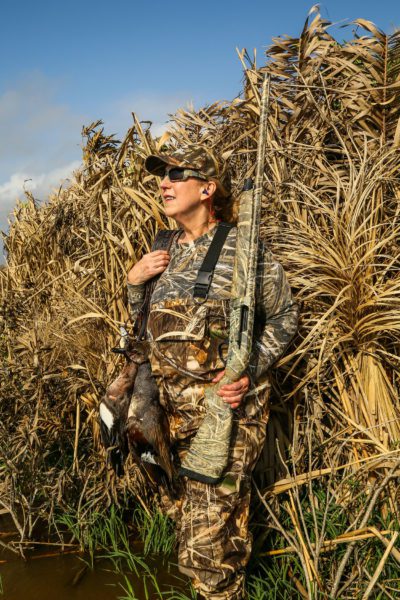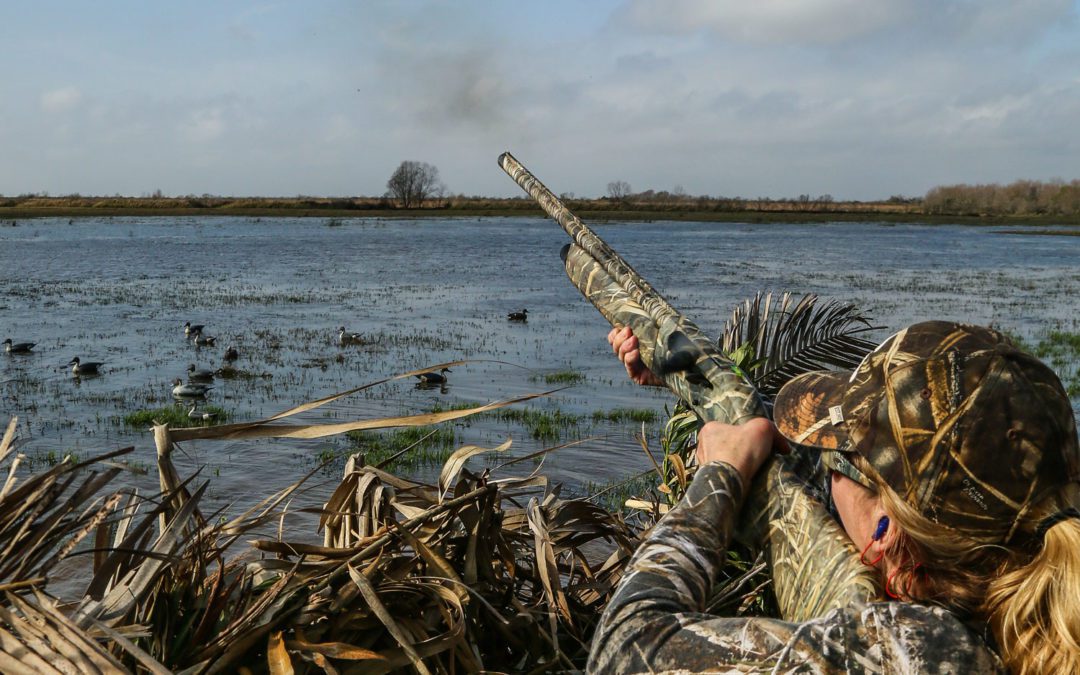It’s a special morning; any morning is when I can watch the sun rise from a duck blind.
Silhouetted against the sunrise, my friend Callie Easterly and her husband, Christian, also wait in companionable silence; to my right, my husband, Shannon, our guide, Alan Hall of Fish ’n’ Fowl Outfitters, and his black Lab Briley scan the predawn skies for the source of distant nasal honking.
We’re Easterly’s guests today, on the Sabine Ranch near Port Arthur, Texas. She serves as the Gulf Coast senior major gifts officer for the Conservation Fund, which purchased this remarkable private coastal ranch in September 2016 for a cool $30 million and is giving us an up-close look at its abundances.
In the near future, the Conservation Fund will donate this 12,376-acre tract, teeming with wildlife and once part of the sprawling 100,000-acre McFaddin Ranch, to the U.S. Fish and Wildlife Service to become part of the adjacent 58,861-acre McFaddin National Wildlife Refuge.

The author praised her 12-gauge Syren XLR5 Waterfowler for its balance, feel, and soft felt recoil.
Directly behind us is Willow Slough, the largest remaining freshwater marsh on the entire Texas Coast, which now serves as a boundary between Sabine Ranch and McFaddin NWR. The wetland will become wholly protected inside the refuge. As the Conservation Fund is nearing its fundraising goal before conveying the ranch to USFWS, today’s hunt will be among the final few before the property becomes public land.
Today’s hunt is one to savor. I’ve become “a woman of a certain age,” and with nearly two decades of waterfowling under my belt, I undoubtedly have more hunts in my rearview mirror than I do over the next horizon. I missed the past year’s season altogether, sidelined by full knee replacement surgery, which makes this morning afield doubly sweet.
I try to etch every moment, every sensory sensation, every scent into memory. Well, the pleasant ones, at least: The mosquitos, bloodthirsty buggers that they are, haven’t got the memo that it’s the dead of winter and swarm around my eyes and mouth. I reach into my blind bag for the ever-present bottle of repellent. Problem solved.
I’ve solved another pesky problem this season as well, one I’ve struggled with throughout my waterfowling seasons, one that took more than a few puffs of DEET-infused mist to remedy. I cast an admiring glance toward the Syren XLR5 Waterfowler resting by my left knee. I call her my “Goldilocks Gun”—not too small, not too big. Just right.
Lady waterfowlers had limited gear choices back when I began duck hunting, but women’s hunting apparel has made great strides since then, in choices tailored to a gal’s smaller frame. Slower to evolve have been shotguns that suit a woman’s build. At 5 feet, 4 inches, my proportions cannot be mistaken for those of a teenaged boy with longer arms and broader shoulders, for which youth models are designed, nor for those of the average guy, for which most shotguns are crafted. Further limiting my choices, I’m left-handed.
Years of trial and error with right-handed guns fitted with shims and with the safety reversed still didn’t solve the annoyance of having shells eject across my face. The left-handed 12 gauge I bought some half-dozen years back solved those problems, but it had a 14 ½-inch length of pull. With the addition of a Rocker Recoil Pad, I could mount the gun a bit more smoothly, but still had to jut the gun out and then back over my bosom before locking it into my shoulder pocket.
With few other options, I made due with the annoyances. Until now.
Syren, a division of Caesar Guerini and Fabarm that launched in 2014, has stepped into the breach to arguably become the women-oriented leader in shotguns. It’s a bold move, but one that should pay off.
Hunter numbers, in decline for many years, dropped by 2 million between 2011 and 2016 according to the preliminary findings of the U.S. Fish and Wildlife Service’s 2016 national survey. While gender-specific data for this survey has not yet been generated, a 2013 survey by the National Sporting Goods Association shows that women’s participation in hunting jumped from 11 percent of all hunters in 2011 to 19 percent in 2013.
Syren’s appeal to a market that’s grown from slightly more than one in ten hunters to nearly one out of every five hunters in just two short years—with no signs of slowing down—is smart business.
The beauty to my left today has a 13 3/4-inch length of pull, and less drop at the comb and heel to accommodate a lady’s longer neck. Its smaller grip radius and reduced wrist diameter and trigger reach are also engineered to fit a woman’s hand.
The Waterfowler—consider it a micro-niche inside the niche Syren dominates with its exquisitely crafted field, sporting, and trap guns—sports a rugged Realtree MAX-5 camo finish and tips the scales at a modest 7.1 pounds.
This is what it’s supposed to feel like, I thought the day I first shot the Syren. Not only is the balance and feel of the gun just feel right, the soft felt recoil, thanks to the stainless-steel, gas-operated Pulse Piston, takes the punishment out of the high-performance 3-inch shells.
Ten minutes before shooting time, Hall instructs us to load up. My left hand embraces the narrow grip of the gun, and I load three copper-tinted Hevi-Steel shells. Just as he signals shooting time, two gadwall drakes strafe the goose decoys.
The gun rises to my shoulder as naturally as if it’s being pulled by a magnet, its stock caressing my cheek. I squeeze the trigger and savor the first of the day’s satisfying splashes.

